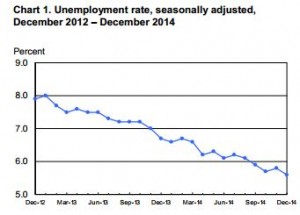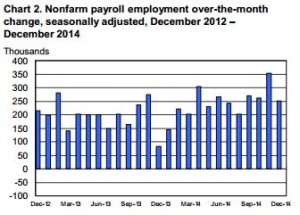The December jobs report released today (Friday) by the U.S. Department of Labor highlights what’s missing in the job market’s recovery: wage growth.
 According to the report, the United States added 252,000 jobs last month, ahead of consensus estimates of 240,000.
According to the report, the United States added 252,000 jobs last month, ahead of consensus estimates of 240,000.
That was enough to push the unemployment rate down to 5.6%.
But those numbers were not enough to distract from the bigger story of falling wages.
Average hourly earnings for all employees on private nonfarm payrolls in December decreased by $0.05 to $24.57. That slippage more than halved November’s hourly wage gain of $0.09.
Hourly earnings of private sector production and nonsupervisory employees slipped by $0.06 to $20.68.
Year over year, average hourly earnings have risen a meager 1.7%. That’s below the paltry 2% pace that prevailed throughout the overall job market recovery. It’s also well below the 3% rate economists say is healthy.
Also troubling in Friday’s jobs report was the uptick in individuals leaving the workforce. Some 300,000 people dropped out of the workforce last month.
 That exodus pushed December’s labor participation rate – the percentage of the civilian population who participated in the labor force by either having a job or actively seeking one – to 62.7%. That’s a drop of 0.2% from November and the lowest rate since February 1978. The labor participation rate has remained stuck in an unhealthy range of 62.7% to 62.9% since April.
That exodus pushed December’s labor participation rate – the percentage of the civilian population who participated in the labor force by either having a job or actively seeking one – to 62.7%. That’s a drop of 0.2% from November and the lowest rate since February 1978. The labor participation rate has remained stuck in an unhealthy range of 62.7% to 62.9% since April.
In addition, a record 92,898,000 Americans did not participate in the labor force in December. That's 456,000 more than the 92,442,000 Americans who didn’t partake in November.
But the wages story is the most troubling…
Stagnant Wages Threaten Economic Growth
Steve Pressman, professor of finance and economics at Monmouth University in West Long Branch, N.J., spoke to Money Morning to explain why the wage growth issue is so concerning.
“The estimate of a large average wage increase in November was revised downward substantially, and today’s report finds a decline in wages in December that nearly wipes out the entire November wage increase that gave us hope last month,” Pressman said.
“Unless wages start rising, the U.S. economy will remain caught in a vicious circle. We need wage growth for economic growth and economic growth for job and income growth.”
Wages pressures are being closely watched as the U.S. Federal Reserve mulls an interest rate hike. With U.S. households still saddled with excessive debt, an interest rate hike would surely hamper the ongoing recovery.
“If the Fed starts raising interest rates this year (as they have hinted), while wages continue to stagnate, consumption can’t increase and stimulate the economy,” Pressman explained.
“Besides slow growth, around half the unemployment decline during the past two years has been due to people leaving the labor force rather than people getting jobs. This is also the main reason for the December drop in the unemployment rate. There are limits to how much more this can happen – people need to work to support themselves and their families.”
Unfortunately, the pink slips just keep coming…
More Major Layoffs Announced This Week
This week alone, four key sector players announced layoffs:
- Department store J.C. Penney Co Inc. (NYSE: JCP) announced Thursday it will shutter 39 stores and lay off 2,250 workers.
- Multinational department store chain owner Macy’s Inc. (NYSE: M) stated Thursday it will close 14 stores, which could result in 2,200 job losses.
- Coca Cola Co. (NYSE: KO) reported Thursday it plans to trim headcount in its corporate, U.S., and international braches by 1,600 to 1,800.
- McDonald’s Corp. (NYSE: MCD) announced Wednesday it is laying off 63 employees at its corporate headquarters.
Those are ominous signs as we kick off 2015.
“With slow economic growth and a need to work, it is unlikely the U.S. unemployment rate can fall by 1 percentage point in 2015 – the average decline in 2013 and 2014,” Pressman concluded. “Something at half this rate or less is likely.”
Don’t Miss Today’s Top Story: The oil price Grinch has extended his stay. And as the first two trading sessions this week have shown, instability in the energy sector remains. But it’s not all bad news. Here’s why lower oil prices actually mean higher profits for some energy players…
Related Articles:
- U.S. Department of Labor: Employment Situation Survey
- Reuters: U.S. Payrolls Rise Solidly, but Weak Wages Steal Limelight
- NY Times: December Caps a Strong Year for Jobs, but Wages Dip


